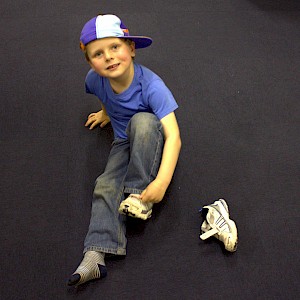What is dressing and why is it important?
Dressing is an activity that is part of everyday living throughout the entire lifespan. As a child becomes older, the ability to achieve an optimal level of independence when dressing is important for them to feel a positive sense of well-being.
What do we need to be able to do when performing basic dressing tasks?
There are many skills that are essential for performing dressing tasks. These include:
- Planning and sequencing skills.
Careful planning is involved before and during the completion of dressing tasks. For example, the ability to select weather appropriate clothing, orientate a shirt correctly and to line up the buttons on a shirt accurately.
Sequencing skills are also required, as dressing tasks tend to involve a number of sequential steps that need to be completed in the correct order. This includes putting on a pull over shirt, tying shoelaces and managing buttons on a dress shirt.
- Body awareness.
When dressing, we may not always be able to see what we are doing. For example, when pulling a shirt over our head and when managing clothes fasteners that are behind our back (i.e. bra clips, zips, buttons, hook and eye clips, etc.). Thus, the ability to know where body parts are positioned in space is important for dressing independence.
- Crossing the midline.
Many dressing tasks involve moving the arms and legs across the imaginary line that runs vertically down the centre of the body. Examples include crossing the arms over to remove a pull-over shirt or jumper; moving the arms over to the one side when putting on a sock or one leg of a pair of pants; as well as moving the arm over to the opposite side when adjusting the sleeve of a shirt.
- Joint range of motion and flexibility.
The ability to move many joints in various directions is essential when performing dressing tasks. For example, when tying shoelaces and putting on socks, shoes and pants; we need to bend the knees and lean the trunk forward in order to bring the foot closer. We also need to bend the elbows and move the arms when putting shirts and when dressing the bottom half of the body. Movement of the joints in the hand and fingers are also involved when managing clothes fasteners and tying shoelaces.
- Balance.
When dressing the lower half of the body, a child is required to lift one foot at time; whether this be when sitting or standing. Therefore, the ability to maintain a balancing position for at least 5-10 seconds at a time is a key skill involved with dressing.
- Core strength and trunk stability.
When dressing, a child is required to lean forward or to the sides. For example when dressing the bottom half of the body (i.e. pants, shoes and socks), reaching for clothes or when adjusting clothing already on the body. The ability to perform these movements and to maintain balance without falling requires adequate strength and stability in the core muscles.
- Bilateral coordination.
The ability to coordinate movements of the fingers, hands and arms are crucial when dressing. They are required to conduct the same movements at the same time; for example when pulling on pants, socks, shoes and jumpers. They are also required to perform movements in a sequential manner; for example when tying shoelaces and when managing clothes fasteners such as buttons and zips.
- Fine motor skills, such as use of a pincer grasp, finger isolation and finger strength.
Precise movements of the fingers are involved when managing clothes fasteners and when tying the shoelaces. Consistent use of a pincer grasp when holding small objects is an important skill required when managing buttons and zips. Finger isolation is also crucial in order to effectively move the laces when tying shoelaces and when holding the base of the zip steady when zipping up a jacket. Finger strength is also required when managing tough clothes fasteners, such as buttons on jeans.
Tips and Tricks!
- Use of visuals that break down the steps involved with specific dressing tasks can be effective for children who have difficulty planning and sequencing through dressing tasks.
- Verbal prompting and modelling throughout the completion of dressing task to reinforce learning and vocabulary.
- Promoting skill development and dressing independence does not necessarily involve practicing dressing over and over again. The skills required for dressing can be developed through engagement in a range of play activities, some examples include:
- Games that involve balancing, maintaining postural positions and moving the limbs across the body, for example Hopscotch, jumping activities, Twister, giant board games (i.e. snakes and ladders) and games that involve rackets or bats (i.e. tennis, cricket and baseball).
- Activities that involve precise and isolated movements of the hands and fingers, for example jewellery making, peeling stickers during craft activities, construction activities that involve nuts and bolts and games that involve use of tweezers (i.e. Giggle Wiggle and Operation).
- Activities and games that involve pushing objects with the fingers and picking up small objects; for example craft activities that involve cutting cardboard and using hole punchers and games such as Monopoly, Trouble and Pop the Pig.
If you have concerns regarding your child’s level of independence with dressing, an occupational therapist can assess each of the skill areas required for dressing and help you address any of the areas in which they are requiring support.
For more information about how an occupational therapist can help your child, visit talkingmatters.com.au or call us on 82557137.
Related Blog Posts
If you liked this post you may also like:
Toilet training
Developing Play Skills
Good Winning and Losing Behaviour
FAQ about therapy



